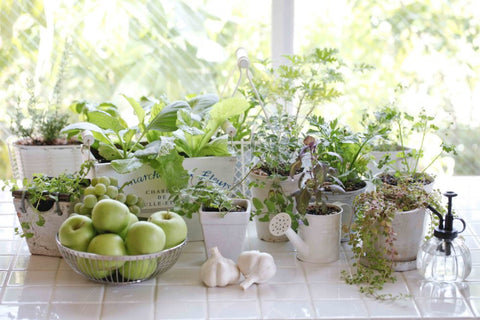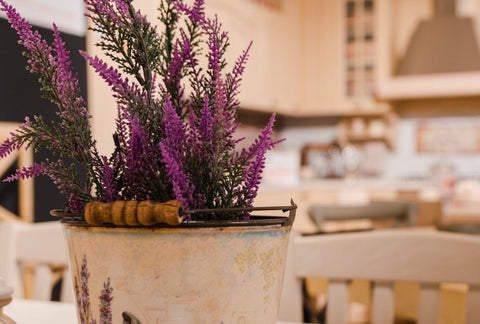An indoor herb garden can easily provide garnishes, spices, and fresh sprigs to your cooking – always on hand, right in your kitchen. In many ways these plants are made for indoor gardening: they’re compact, easy to take care of, and only need moderate amounts of light and nutrients. From a gardening standpoint, they fall into two categories (drier and wetter soil), so by just learning a couple of techniques, you’ll be able to grow them all. In this intro, we’ll cover the different types of herbs suitable for indoor gardening, their ideal growing conditions, and the skills you’ll learn to keep your garden productive & tidy.
Indoor herb plants: What can you grow indoors?
You can grow all herbs indoors! The approach we take to gardening is to think about the plant’s native habitat, then replicate it in a small container. Fortunately, all herbs are covered by just two groupings: ones that like rocky, dry soil and ones that like rich, moist soil.
Herbs That Grow in Dry & Rocky Soil
It’s surprising how many of our favorite herbs don’t actually like the rich moist soil that you’d picture in an “ideal garden”. Many of these originate from the Mediterranean climate – where they evolved to thrive on dry and rocky cliff sides and mountaintops. Because they’re so tough, they’re also usually added at the beginning of cooking to slowly release their flavor. You can identify these herbs by their woody stems, smaller leaves, or silvery green color. The group includes:

Herbs That Grow in Moist & Rich Soil
These are some of the best herbs to have fresh – they are fast growers, but quickly wilt after being picked. They originate from river banks and low lying areas and have been long cultivated to thrive in classic garden soil, rich in water and nutrients. They typically have tender stems, and are added fresh to finish off a dish. The group includes:

How To Start An Indoor Herb Garden: Supplies & Setup
Setting up an herb garden is simple, and with a little upfront investment, you will have a low-maintenance kitchen garden that will pay for itself after a few harvests (not to mention the big step up in produce quality).
How much light do you need?
You need 6 hours of direct sunlight to grow herbs – though some, especially the Mediterranian herbs, prefer even more. While many homes have a bright windowsill that will work just fine, most people don’t get quite enough sunshine for herbs to thrive. If you’re in this second group, or just want faster growth with year-round consistency, grow lights can provide ideal conditions. If you’re not sure about your lighting situation or what to do, our lighting for herbs blog has a straightforward guide to getting all set up.
What type of planters & soil should you use?
A perfect setup uses a ceramic self watering planter, High-N nutrients, and for soil, a bonsai mix for the mediterranean herbs and a potting mix for the soft herbs. You can read about our grow tests [coming soon] to understand why we recommend ceramic self watering planters over other options (hydroponics, wicking planters, pot & soil) but they win in terms of value, ease of use, and plant health for pretty much every plant. After it’s filled (just once per week) it automatically keeps the soil moisture at a set level – so there’s no under or over watering. We’ve got complete setup guides for rocky, dry conditions as well as rich, moist soil where we recommend potting mixes, watering instructions, and how often to add fertilizer for each of the herbs.
Growing & Harvesting your Indoor Herbs
Pruning your herbs to be productive & tidy
With just a couple snips at the right times you can get a small garden to continually produce all the herbs you need. We’ll cover which to start from seed, live plant, or cutting. You’ll also learn about how to thin your seedlings, maximize your plant through pruning, and harvest the best tasting leaves.
Cooking with Fresh Herbs: Hard Herbs vs Soft Herb
Herbs are especially versatile and can brighten up any dish – even if you’re just adding some fresh basil to a canned tomato soup. Understanding the difference in hard and soft herbs will help you cook intuitively, but if you need some inspo, we’ve got an extensive recipe section here [coming soon].
Hard Herbs
These are the ones that you usually add at the beginning of cooking to slowly release their flavor – like rosemary, oregano, and thyme. These plants have woody stems, are long lived, like drier soil, and grow a little bit slower. When it comes time to store them, they’re best wrapped in a paper towel in a sealed container.
Soft Herbs
These have tender stems, and are typically added fresh to finish off a dish. This is a big category – with plants that prefer drier soil (cilantro, dill, scallion), moist soil (mint, parsley, basil). These are also some of the best herbs to have fresh – as you often only need a little and they wilt fast in the supermarket. Store them like fresh flowers – cut in a glass










There are no comments for this article. Be the first one to leave a message!